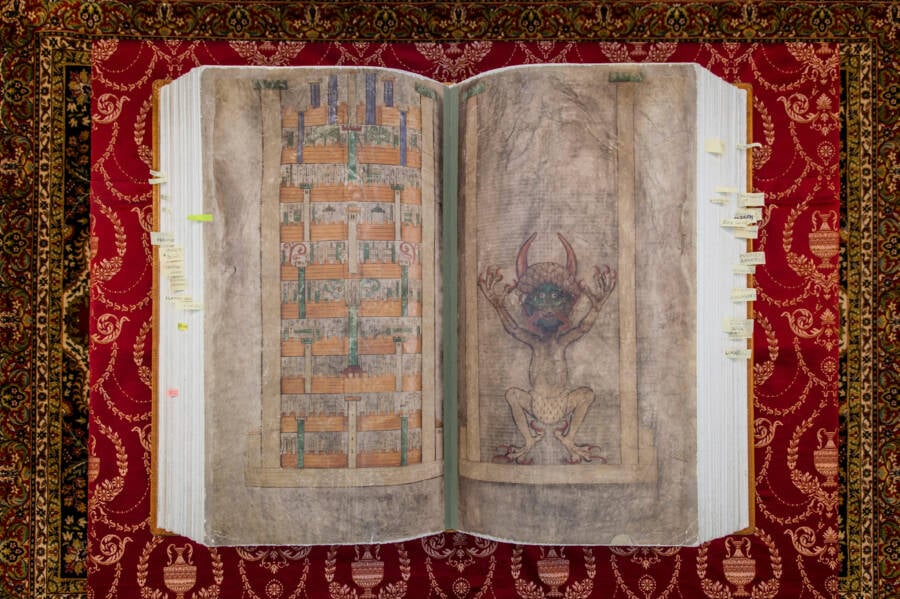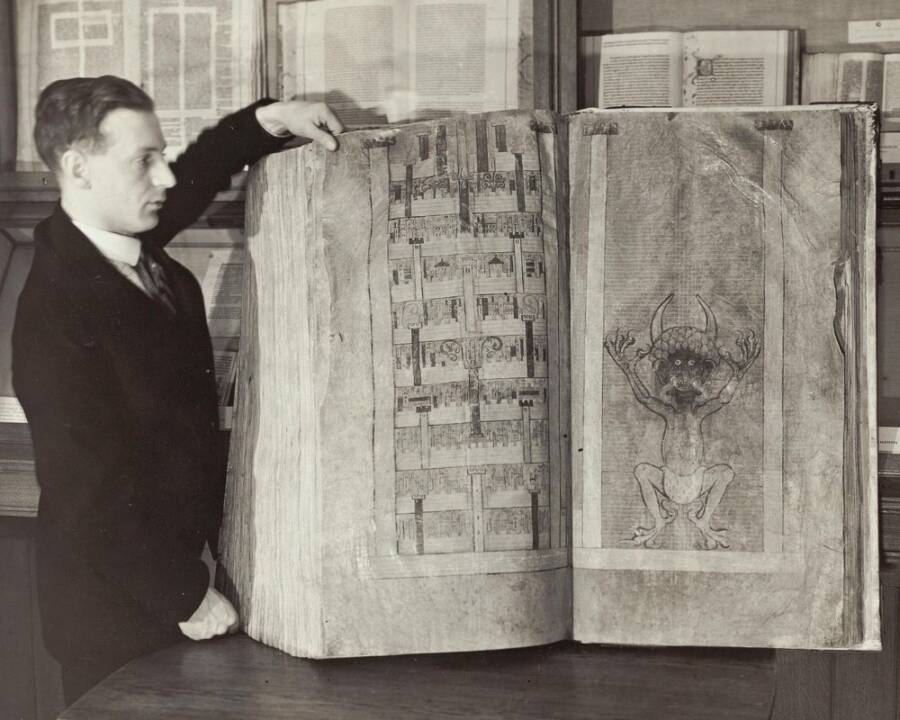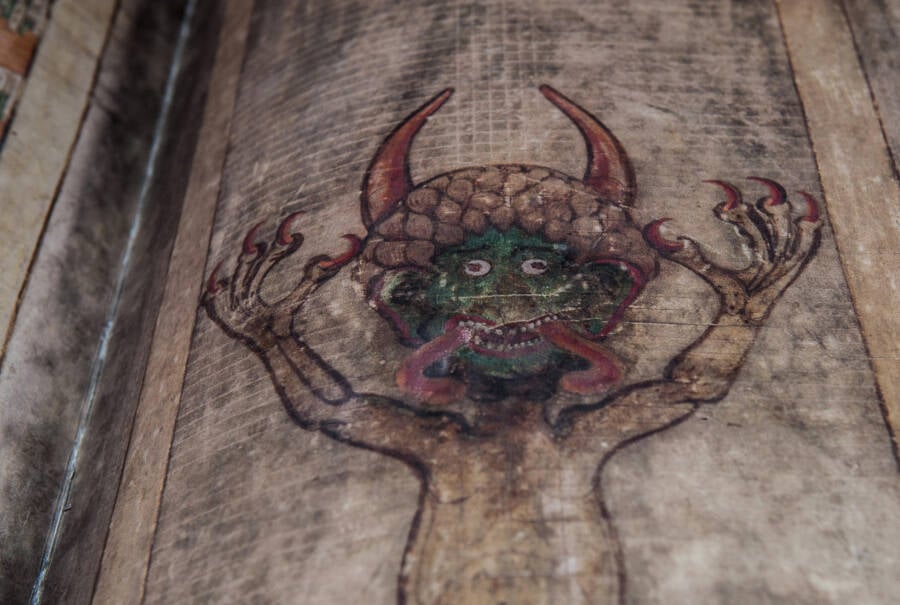The 620-page Codex Gigas stands nearly 36 inches high and may have taken 25 years for a single monk to write.

CTK/Alamy Stock PhotoThe Codex Gigas, also known as the Devil’s Bible, is the largest known medieval manuscript in the world.
The Codex Gigas is the largest surviving Medieval manuscript in the world. The massive volume comprises both the Old and New Testaments alongside an assortment of other historical texts and is held at the National Library of Sweden in Stockholm.
The 165-pound book is about 35 inches high, 20 inches wide, and 8.7 inches thick. In fact, it’s so large that it reportedly took the vellum of 160 donkeys to create the manuscript’s 620 pages.
But while its enormous size is indeed impressive, the Codex Gigas is perhaps better known for the striking, 19-inch-high depiction of the Devil that appears on its 577th page. It’s this illustration that lends the book its nickname: the Devil’s Bible.
There are several versions of the legend behind the creation of the Codex Gigas, but each is equally intriguing — and mysterious.
The History Of The Giant Manuscript
According to the National Library of Sweden, the Codex Gigas was likely written between 1204 and 1230 C.E. The first owner on record was the Podlažice Monastery in Bohemia, but it’s unknown if that’s where the manuscript was originally created.
Around 1295, as detailed in a note in the front of the Codex, the monks of Podlažice pledged the book to another monastery in Sedlec, and yet another monastery purchased it later that year.
Then, in 1594, the Devil’s Bible fell into the hands of Holy Roman Emperor Rudolf II. He reportedly borrowed the book from the monastery — but he had no intention of ever returning it. At the time, it had become a prized collector’s item.

National Library of SwedenA library employee standing next to the Devil’s Bible, 1929.
Just 50 years later, the Swedish army stole the Codex Gigas during the Siege of Prague at the end of the Thirty Years’ War. Looters brought the manuscript back to Stockholm, where it eventually ended up in the library of the royal palace.
One tale about the history of the Devil’s Bible notes that there was a fire in the castle in 1697. The librarian threw it out of a window to save it — and the massive book injured a bystander below as it fell.
In 1878, the treasured manuscript was moved to the National Library of Sweden, where it sits to this day in glass box, illuminated for the world to see.
The Legend Behind The Codex Gigas
While the actual history of the Codex Gigas is fascinating enough, the legends about its creation are even more captivating.
In the 13th century, a Benedictine monk named Herman the Recluse resided at a monastery near the town of Chrudim in Bohemia (modern day Czechia).
All versions of the legend state that Herman broke his monastic vows, but accounts vary on what his punishment was. Some say that he was sentenced to immurement, locked away behind a wall and sealed in until he could complete a book that contained all earthly knowledge. The process of live entombment wasn’t exactly unusual for monks or nuns who broke their vows — though it didn’t normally come with such a lofty stipulation.
According to Heritage Daily, another version of the legend tells that Herman was originally going to be immured and left to die of dehydration and starvation, but he begged the Abbot for one year to complete the text and earn his freedom.
Yet another version states that Herman had just a single night to create the expansive manuscript.

CTK/Alamy Stock PhotoThe Codex Gigas manuscript was written in Bohemia in the early 13th century.
Regardless of his exact punishment, Herman began to work on the compendium that would eventually become the Codex Gigas. As midnight approached on the last night of the year (or as dawn broke at the end of the single night he worked, depending on the version of the story), the monk knew he could not finish the book. At that moment, the Devil himself appeared to Herman, and the two made a deal: the monk’s soul in exchange for the ability to complete the Codex.
Some even say the large, full-page illustration of the Devil on page 577 of the manuscript may in fact have been drawn as a way of thanking the unholy spirit for his help in completing the task — and thus saving Herman’s life.
However, much about the legend is speculative. The book was likely handwritten by a single monk, but whether or not that man really was Herman the Recluse is still up for debate.
What’s Inside The Devil’s Bible?
While the validity of Herman’s plight to create the Codex Gigas may be nothing more than legend, it doesn’t make the manuscript itself any less impressive.
As the National Library of Sweden highlights, writing the Devil’s Bible was no small feat. Even if the scribe worked for six hours per day and six days per week, it would have taken him at least five years to complete. If the creator was a monk, as many have suggested, he would likely have only been able to work on the book for about three hours a day — meaning it would have taken him about 10 years to write the Codex Gigas.
This doesn’t even factor in the multitude of illustrations or the possibility that the scribe may have first lined the pages to guide his writing. All things considered, it may very well have taken a single monk 20 or 30 years to complete the Devil’s Bible.

CTK/Alamy Stock PhotoThe Devil’s Bible contains the complete Vulgate, a Latin translation of the Holy Bible from the fourth century C.E.
No matter how you look at it, the Codex Gigas is impressive — and that’s not to mention the book’s actual content.
Inside its massive pages are the entirety of the Old and New Testaments written in Latin as well as other medieval reference texts. These include two Jewish histories by Flavius Josephus: Antiquities of the Jews and The Jewish War. The Codex Gigas also contains Isidore of Seville’s encyclopedia Etymologies, a Bohemian chronicle written by Cosmas of Prague, a calendar, and a collection of shorter texts on topics such as grammar, medicine, and exorcisms.
From its stunning white leather cover to the wealth of information and stunning illustrations inside, the Codex Gigas remains a wonder of the world, even 800 years after it was created.
After learning about the Codex Gigas, also known as the Devil’s Bible, discover who really wrote the Christian Bible. Then, read about the mystery of the 600-year-old Voynich Manuscript.





